総括班刊行物
『危機に瀕した言語について:講演集(一)』(C-001)
Lectures on Endangered Languages: 1
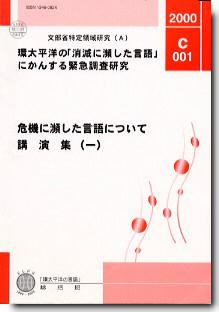
目次
CONTENTS
CONTENTS
|
はじめに Preface |
崎山 理 Osamu SAKIYAMA |
1 |
|
危機に瀕した言語の研究:何を為すべきか Endangered Languages Research:What is expected of us? |
山本 昭 Y.Yamamoto Akira |
3 |
|
危機言語の記録と資料提供の必要 The Necessity of Recording Endangered Languages and Making these Records Available |
田村すず子 Suzuko TAMURA |
33 |
|
本研究プロジェクトと北方言語研究 Northern Languages Studies for this Project |
池上二良 Jiro IKEGAMI |
73 |
|
日本における危機に瀕する言語および関連する言語学上の諸問題 Endangered Languages in Japan |
上村幸雄 Yukio UEMURA |
77 |
|
重点領域研究「日本語音声」の目的・成果および音声データベースの一例
—「P音考」その後 The Aim and Results of "Project on Japanese Prosody", with an Example for Use of the Speech Data-base Produced by the Project: "The Study of P −sound" reconsidered |
杉藤美代子 Miyoko SUGITO |
93 |
『危機に瀕した言語について:講演集(2)』(C-002)
Lectures on Endangered Languages: 2 — From Kyoto Conference 2000 —
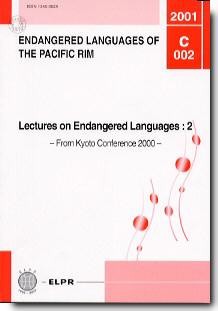
CONTENTS
|
Preface Endangered Languages: The Crumbling of the Ecosystem of Language and Culture |
Osahito MIYAOKA | 3 |
|
Mass Language Extinction, and Documentation: The Race against Time |
Michael Krauss | 19 |
|
Comments on "Mass Language Extinction and Documentation: The Race against Time" by Michael E. Krauss |
Megumi KUREBITO | 41 |
| Global Language Viability | Barbara F. Grimes | 45 |
| A Commentary on "Global Language Viability" by Barbara F. Grimes | Darrell Tryon | 63 |
| Comments on Global Language Viability by Barbara F. Grimes | Sueyoshi TOBA | 67 |
| Descriptive linguistics and the standardization of newly described languages | Willem F.H. Adelaar | 69 |
| Prosody in the Description of Endangered Languages | Cecilia Odé | 81 |
| Comment on W. F. H. Adelaar's Paper: Descriptive linguistics and the standardization of newly described languages | Kazuto MATSUMURA | 87 |
| Language Endangerment through Marginalization and Globalization | Matthias Brenzinger | 91 |
| Look for the stick: Some remarks on globalization and language endangerment | George Aaron Broadwell | 117 |
| Comments on "Language Endangerment through Marginalization and Globalization" by Matthias Brenzinger | Shigeki KAJI | 123 |
| Language Endangerment and Death — Ways and Methods for Maintaining and Reinvigorating Endangered Languages — | Stephen A. Wurm | 127 |
| A Commentary on Dr. Wurm's Paper and Revitalization of Fueguian Languages | Oscar E. Aguilera F. | 141 |
| A Commentary on "Language Endangerment and Death — Ways and Methods for Maintaining and Reinvigorating Endangered Languages by Stephen A. Wurm — | Midori OSUMI | 147 |
| Language Attitudes: The Key Factor in Language Maintenance | David Bradley | 151 |
| Comments on the paper by David Bradley | Toshihide NAKAYAMA | 161 |
| Some Comments upon Prof. David Bradley's "Language Attitudes: The Key Factor in Language Maintenance" | Takumi IKEDA | 165 |
| What does it mean for a language to survive? Some thoughts on the (not-so-simple) future of small languages | Victor Golla | 171 |
| Beyond the Brink: What Legacy Can Be Left in Spite of All Comments on Golla's Paper | Colette Grinevald | 179 |
| Comments on Dr. Victor Golla's paper | Honoré WATANABE | 185 |
| Endangered Languages in Japan, and Related Linguistic Problems | Yukio UEMURA | 187 |
| Linguistic Arrogance and Endangered Languages: Japanese and Ryukyuan Comments to Uemura's Paper | Michael E. Krauss | 203 |
| Comments on Professor UEMURA Yukio's paper: "Endangered Languages in Japan and Related Linguistic Problems" | Zendo UWANO | 207 |
| General Comments: Documenting and/or Preserving Endangered Languages | Bernard Comrie | 213 |
| Revitalization of Kawésqar and Yaghan in Magallanes (Chile) Governmental Actions Towards the Rescue of two Endangered Fueguian Languages | Nelson Aguilera A. | 223 |
| Bilingual Intercultural Education in Chile: An Unfinished Project | José Tonko P. | 237 |
| Alutor: Endangerment, state of documentation, and typological importance | A. E. Kibrik | 249 |
| Fighting for the future of Forest Nenets | Tapani Salminen | 251 |
| Rumours of a Dragon | Nicholas Ostler | 257 |
| Role and ethics of researchers and method of documentation | Tasaku TSUNODA | 261 |
| Two Highly Effective Models for Large-scale Documentation of Endangered Languages | Terrence Kaufman | 269 |
| Encounters at the Brink: Linguistic Fieldwork among Speakers of Endangered Languages | Colette Grinevald | 285 |
| Endangered Indigenous Languages of Venezuela, New Governmental Policy and Projects of Revitalisation: The particular case of two Carib languages, Mapoyo and Yawarana | Marie-Claude Mattei Muller | 315 |
| Listen to the Voices of the Indigenous Peoples | Akira Y. YAMAMOTO | 335 |
| Epilogue | Osamu SAKIYAMA | 343 |
『危機に瀕した言語について:講演集(三)』(C-003)
Lectures on Endangered Languages: 3
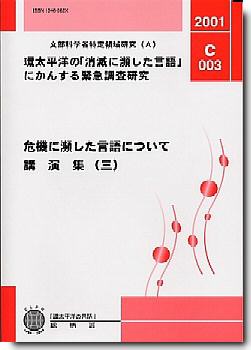
目次
CONTENTS
CONTENTS
|
はじめに Preface |
崎山 理 Osamu SAKIYAMA |
|
|
死語のプロセス — 言語交替と言語干渉、東アフリカの場合 — A Typological Study of Language Death: Language Shift and Language Contact |
稗田 乃 Osamu HIEDA |
1 |
|
類別詞に関する理論的考察 A Theoretical Perspective on Numeral Classifier Systems |
AUTH西光 義弘 Yoshihiro NISHIMITSUOR |
13 |
|
アイヌ語復興運動の現状とアイヌ語研究者の責任 Present Situation of the Ainu Language Revival Movement and the Responsibility of Researchers |
奥田 統己 Osami OKUDA |
25 |
|
日本語の<危機> 'Endangered' Japanese |
宮島 達夫 Tatsuo MIYAJIMA |
35 |
|
言語記述の科学性をめぐって — メタ言語理論の試み — Meta-theoretical Approach to the Descriptive Adequacy, or Yet Another Cartesian Linguistics |
峰岸 真琴 Makoto MINEGISHI |
55 |
|
生物多様性と言語の多様性 — オセアニアの視点から — Biodiversity and Linguistic Diversity — from an Oceanian Perspective |
大西 正幸 Masayuki ONISHI |
69 |
|
ムチギン・ジャジェチアン(私たちの家族)ができるまで — コリャーク語保存の一つの小さな試み — How We Have Made Muchgin JajEch'En (Our Family) — A Small Attempt to Preserve the Koryak Language |
呉人 恵 Megumi KUREBITO |
79 |
|
ムラブリ族(黄色い葉の精霊)の現状と未来 — 危機言語と言語学者の役割 — The Mlabri in the Present and the Future — Endangered Languages and Linguists |
坂本 比奈子 Hinako SAKAMORO |
87 |
崎山理・遠藤史・渡辺己・笹間史子 編
『危機に瀕した言語について:講演集(4)』(C-004)
Osamu SAKIYAMA, Fubito ENDO, Honoré WATANABE and Fumiko SASAMA eds.
Lectures on Endangered Languages: 4 — From Kyoto Conference 2001 —

CONTENTS
| Preface | Osahito MIYAOKA | v |
| Globalization and Traditional Culture in Asian Countries | Hinako SAKAMOTO | vii |
| I. Keynote Speeches and Special Presentations | ||
| Linguistics Research at Home: Making It Our Own, for Our Own | Ofelia Zepeda | 3 |
| Facing the Language Endangerment Crisis in the 21st Century: Where Are We Now? | Luisa Maffi | 13 |
| The World's Languages in Crisis: Questions, Challenges, and a Call for Action | Michael Krauss, Luisa Maffi and Akira Y. YAMAMOTO | 23 |
| UNESCO's Programme on Languages | Noriko AIKAWA | 29 |
| Online Dictionary Project for Southwestern Languages | Mizuki MIYASHITA | 37 |
| II. Panel Discussion 1: Problems of Documentation | ||
| Lexical Documentation of Endangered Languages | Michael Krauss | 47 |
| On the Problem of Recording Folklore Texts | M. M. Khasanova | 51 |
| Documentation of Grammar | Christian Lehman | 61 |
| Let the Language Be the Guide: How Can We Capture the Internal Logic of the Language? | Toshihide NAKAYAMA | 75 |
| Usage-based and Knowledge-based Descriptions | Irina Nikolaeva | 81 |
| Training (Young Students) in Field Research | Tasaku TSUNODA | 91 |
| The Holistic Approach to Endangered Language Documentation: Research Philosophy of the Himalayan Languages Project | George van Driem | 103 |
| Discussion | 111 | |
| III. Panel Discussion 2: Speakers/Community vs. Linguists | ||
| Native American Communities and Linguistic Researchers | Akira Y. YAMAMOTO | 145 |
| The Researcher, Speaker, and Local Body Authority in Ryukyu Language Research | Shigehisa KARIMATA | 147 |
| The Ainu Language: Its Indigenous Status and Revitalization Movements | Shiro KAYANO | 153 |
| Language Endangerment: Five Generations of Speakers and Linguists | Alexander M. Pevnov | 159 |
| Language Endangerment and Language Revitalization in Thailand: A Case Study of Chong | Premsrirat Suwilai | 169 |
| Negotiating Against Loss: Responsibility, Reciprocity, and Respect in Endangered Language Research | Patricia A. Shaw | 181 |
| Hardships and Hopes: Revitalization of Fueguian Languages in Chile | Oscar E. Aguilera F. | 195 |
| The View from Within. Revitalization of Kawésqar Language: Achievements and Perspectives | José S. Tonko P. | 209 |
| Discussion | 215 | |
| Epilogue | Osamu SAKIYAMA | 241 |
崎山理・遠藤史 編 『危機に瀕した言語について:講演集(5)』(C-005)
Osamu SAKIYAMA and Fubito ENDO eds. Lectures on Endangered Languages: 5
— From Tokyo and Kyoto Conferences 2002 —
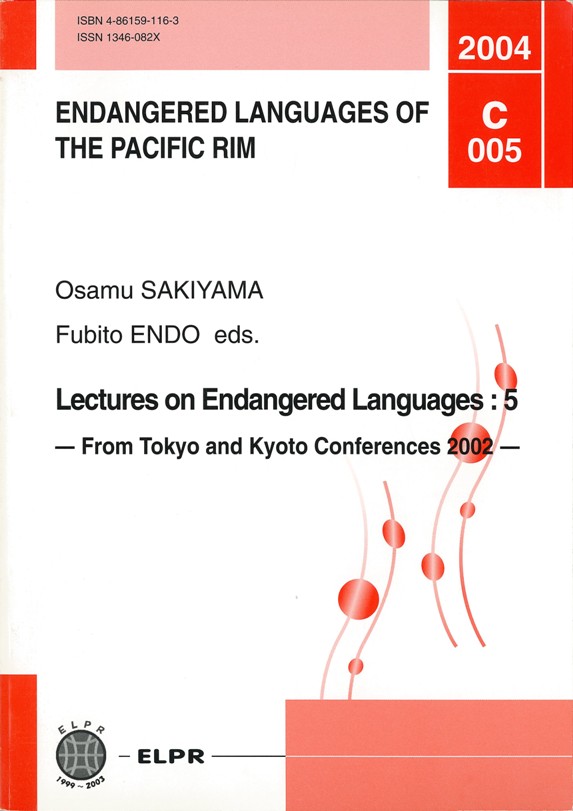
CONTENTS
| Preface | Osamu SAKIYAMA and Fubito ENDO | iii |
| Part I: From Tokyo Conference 2002 | ||
| 1. Language Engangerment in the CIS: Seeking for Positive Tendencies | Olga Kazakevitch | 3 |
| 2. What are Endangered Languages? : Different Perspectives | Akira Y. YAMAMOTO | 21 |
| 3. Documentary and Descriptive Linguistics | Nikolaus P. Himmelmann | 37 |
| 4. Significance of studying Endangered Languages from the View Point of Studying Dead Languages | Masahiro SHOGAITO | 85 |
| Part II: From Kyoto Conference 2002 | ||
| 5. Language Endangerment in the Sepik Area of Papua New Guinea | Alexandra Y. Aikhenvald | 97 |
| 6. Voices of Tundra and Taiga: Endangered Languages of Russia on the Internet | Tjeerd de Graaf | 143 |
| 7. Language Preservation in Venezuera: Recent Developments and Field Projects | María E. Villalón | 171 |
| 8. On Language Situation and Revitalization Efforts of Alaskan Central Yupi'k | Elsie Mather | 195 |
| 9. From My Experiences of Teaching Koryak (in Russian) | Tat'yana Y. Yermolinskaya | 205 |
| Epilogue | Osamu SAKIYAMA | 213 |
崎山理 『西太平洋地域における少数民族言語の研究』(C-006)
Osamu SAKIYAMA "Studies of Minority Languages in the Western Pacific Rim"
CONTENTS
| Preface | vii |
| PART ONE : Comparative Studies of Trukic Languages in the Central and West Caroline Islands | |
| 1. Genealogical Identification of Languages in the Western Carolines | 3 |
| 2. East-West Cultural Exchanges in the Western Carolines | 17 |
| 3. Genealogical Positions of Trukic, Ponapeic and Kusaiean Languages | 29 |
| 4. Linguistic Evidences of New Guinea-Micronesia Connection | 37 |
| PART TWO : Sociolinguistic and Anthropological Linguistic Studies of the Pacific | |
| 5. Linguistic and Cultural Times Running in Oceania and Southeast Asia | 47 |
| 6. Language Unification and the Fate of Regional Languages in Multiethnic, Multilingual States: Indonesia, Papua New Guinea, and Micronesia | 69 |
| 7. Pidgin Japanese on Micronesia's Belau | 81 |
| 8. Endangered Languages of the Pacific | 93 |
| PART THREE : Individual Language Studies | |
| 9. The Characteristics of Nguluwan from the Viewpoint of Language Contact | 107 |
| 10. Nominals of Fatamanue, Seram Maluku : A Subgrouping Argument in Central Malayo-Polynesian | 129 |
| 11. The Phonological Systems of Tarama-jima and Minna-jima Dialects in the Ryukyu Islands | 149 |
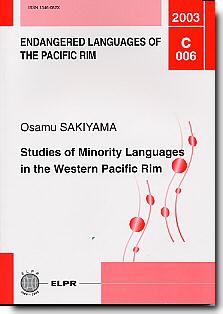 全文PDF/Fulltext PDF
全文PDF/Fulltext PDF